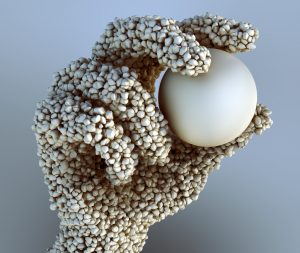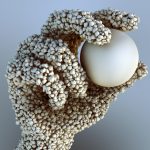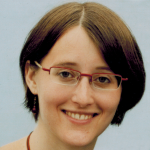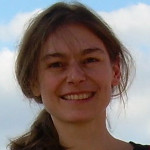PAPS

I am text block. Click edit button to change this text. Lorem ipsum dolor sit amet, consectetur adipiscing elit. Ut elit tellus, luctus nec ullamcorper mattis, pulvinar dapibus leo.
Partners




Publications
2019
Conference papers
-
- titre
- mpLBP: An Extension of the Local Binary Pattern to Surfaces based on an Efficient Coding of the Point Neighbours
- auteur
- Elia Moscoso Thompson, Silvia Biasotti, Julie Digne, Raphaëlle Chaine
- resume
- The description of surface textures in terms of repeated colorimetric and geometric local surface variations is a crucial task for several applications, such as object interpretation or style identification. Recently, methods based on extensions to the surface meshes of the Local Binary Pattern (LBP) or the Scale-Invariant Feature Transform (SIFT) descriptors have been proposed for geometric and colorimetric pattern retrieval and classification. With respect to the previous works, we consider a novel LBPbased descriptor based on the assignment of the point neighbours into sectors of equal area and a non-uniform, multiple ring sampling. Our method is able to deal with surfaces represented as point clouds. Experiments on different benchmarks confirm the competitiveness of the method within the existing literature, in terms of accuracy and computational complexity.
- Accès au texte intégral et bibtex
-


2018
Journal articles
-
- titre
- Sparse Geometric Representation Through Local Shape Probing
- auteur
- Julie Digne, Sébastien Valette, Raphaëlle Chaine
- resume
- We propose a new shape analysis approach based on the non-local analysis of local shape variations. Our method relies on a novel description of shape variations, called Local Probing Field (LPF), which describes how a local probing operator transforms a pattern onto the shape. By carefully optimizing the position and orientation of each descriptor, we are able to capture shape similarities and gather them into a geometrically relevant dictionary over which the shape decomposes sparsely. This new representation permits to handle shapes with mixed intrinsic dimensionality (e.g. shapes containing both surfaces and curves) and to encode various shape features such as boundaries. Our shape representation has several potential applications; here we demonstrate its efficiency for shape resampling and point set denoising for both synthetic and real data. Index Terms—Shape similarity-Local shape descriptor-Point set denoising and resampling.
- Accès au texte intégral et bibtex
-


-
- titre
- Wavejets: A Local Frequency Framework for Shape Details Amplification
- auteur
- Yohann Béarzi, Julie Digne, Raphaëlle Chaine
- resume
- Detail enhancement is a well-studied area of 3D rendering and image processing, which has few equivalents for 3D shape processing. To enhance details, one needs an efficient analysis tool to express the local surface dynamics. We introduce Wavejets, a new function basis for locally decomposing a shape expressed over the local tangent plane, by considering both angular oscillations of the surface around each point and a radial polynomial. We link the Wavejets coefficients to surface derivatives and give theoretical guarantees for their precision and stability with respect to an approximate tangent plane. The coefficients can be used for shape details amplification, to enhance, invert or distort them, by operating either on the surface point positions or on the normals. From a practical point of view, we derive an efficient way of estimating Wavejets on point sets and demonstrate experimentally the amplification results with respect to noise or basis truncation.
- Accès au texte intégral et bibtex
-


-
- titre
- Super-resolution of Point Set Surfaces using Local Similarities
- auteur
- Azzouz Hamdi-Cherif, Julie Digne, Raphaëlle Chaine
- resume
- 3D scanners provide a virtual representation of object surfaces at some given precision that depends on many factors such as the object material, the quality of the laser-ray or the resolution of the camera. This precision may even vary over the surface, depending for example on the distance to the scanner which results in uneven and unstructured point sets, with an uncertainty on the coordinates. To enhance the quality of the scanner output, one usually resorts to local surface interpolation between measured points. However, object surfaces often exhibit interesting statistical features such as repetitive geometric textures. Building on this property, we propose a new approach for surface super-resolution that detects repetitive patterns or self-similarities and exploits them to improve the scan resolution by aggregating scattered measures. In contrast with other surface super-resolution methods, our algorithm has two important advantages. First, when handling multiple scans, it does not rely on surface registration. Second, it is able to produce super-resolution from even a single scan. These features are made possible by a new local shape description able to capture differential properties of order above 2. By comparing those descriptors, similarities are detected and used to generate a high-resolution surface. Our results show a clear resolution gain over state-of-the-art interpolation methods.
- Accès au texte intégral et bibtex
-


Conference papers
-
- titre
- Correcting Motion Distortions in Time-of-Flight Imaging
- auteur
- Beatrix-Emőke Fülöp-Balogh, Nicolas Bonneel, Julie Digne
- resume
- Time-of-flight point cloud acquisition systems have grown in precision and robustness over the past few years. However, even subtle motion can induce significant distortions due to the long acquisition time. In contrast, there exists sensors that produce depth maps at a higher frame rate, but they suffer from low resolution and accuracy. In this paper, we correct distortions produced by small motions in time-of-flight acquisitions and even output a corrected animated sequence by combining a slow but high-resolution time-of-flight LiDAR system and a fast but low-resolution consumer depth sensor. We cast the problem as a curve-to-volume registration, by seeing a LiDAR point cloud as a curve in a 4-dimensional spacetime and the captured low-resolution depth video as a 4-dimensional spacetime volume. Our approach starts by registering both captured sequences in 4D, in a coarse-to-fine approach. It then computes an optical flow between the low-resolution frames and finally transfers high-resolution details by advecting along the flow. We demonstrate the efficiency of our approach on both synthetic data, on which we can compute registration errors, and real data.
- Accès au texte intégral et bibtex
-


Habilitation à diriger des recherches
-
- titre
- Contributions to local and non-local surface analysis
- auteur
- Julie Digne
- resume
- Following the recent progress of surface acquisition systems, geometry processing algorithms quickly evolve to deal with the variety of data types and acquisition quality. This habilitation manuscript details some recent approaches to tackle this challenge. First, for low-quality data, it is necessary to improve the measure by denoising or super-resolution algorithms. Self-similarity analysis yields efficient methods for improving the acquisition quality either for real object surfaces, or generalized shapes (shapes whose intrinsic dimension is not constant). Beyond low-resolution acquisition, taking this similarity into account also permits to compress point set surfaces, that can then be resampled during decompression. While geometric data are \emph{per se} a research topic, additional image data or other type of measures can be acquired simultaneously, which allows to complete or augment the geometric information through a joint analysis. This manuscript addresses this multi-captor data problem to augment urban scenes point sets by using a collection of pictures, which permits to colorize point clouds, once images are accurately registered. Finally, for specific purposes, it is interesting to represent surfaces as polygonal meshes potentially replacing several points by a single planar facet. To do so, this manuscript describes an Optimal Transportation metric between the initial point cloud and a mesh. The reconstruction and optimization of the mesh can then be driven by the minimization of this distance.
- Accès au texte intégral et bibtex
-


2017
Journal articles
-
- titre
- The Bilateral Filter for Point Clouds
- auteur
- Julie Digne, Carlo de Franchis
- resume
- Point sets obtained by 3D scanners are often corrupted with noise, that can have several causes, such as a tangential acquisition direction, changing environmental lights or a reflective object material. It is thus crucial to design efficient tools to remove noise from the acquired data without removing important information such as sharp edges or shape details. To do so, Fleish-man et al. introduced a bilateral filter for meshes adapted from the bilateral filter for gray level images. This anisotropic filter denoises a point with respect to its neighbors by considering not only the distance from the neighbors to the point but also the distance along a normal direction. This simple fact allows for a much better preservation of sharp edges. In this paper, we analyze a parallel implementation of the bilateral filter adapted for point clouds. Source Code The ANSI C++ source code permitting to reproduce results from the on-line demo is available on the web page of the article 1 .
- Accès au texte intégral et bibtex
-


2016
Conference papers
-
- titre
- Surface derivatives computation using Fourier Transform
- auteur
- Yohann Béarzi, Julie Digne
- resume
- We present a method for computing high order derivatives on a smooth surface S at a point p by analyzing the vibrations of the surface along circles in the tangent plane, centered at p. By computing the Discrete Fourier Transform of the deviation of S from the tangent plane restricted to those circles, a linear relation between the Fourier coefficients and the derivatives can be expressed. Thus, given a smooth scalar field defined on the surface, all its derivatives at p can be computed simultaneously. The originality of this method is that no direct derivation process is applied to the data. Instead, integration is performed through the Discrete Fourier Transform, and the result is expressed as a one dimensional polynomial. We derive two applications of our framework namely normal correction and curvature estimation which we demonstrate on synthetic and real data.
- Accès au texte intégral et bibtex
-












